
views
Choosing the Music

Find a backing track. Some people like to start their song by writing the lyrics, but if you’re not an experienced songwriter, it can be tricky to find a melody or track to fit those lyrics. Look for a beat that you like, then write the rest of the song to fit that beat. You should also consider using a slower beat if you are planning to write a love song that is sensual and sexy for your crush. Pay close attention to the melody and rhythm of the track and try to fit your lyrics into what’s already there. If your crush likes a certain genre of music, like pop or hip hop, you can also look for a backing track that falls within that genre.
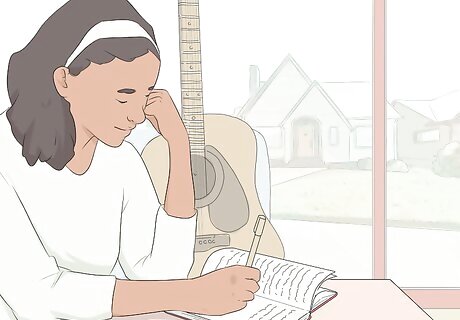
Write the melody yourself. If you play an instrument or are musically inclined, you may be able to write the melody for the song yourself. Start by picking a simple chord progression, then build the melody for the song on top of that. Try strumming or playing the chord progression while vocally improvising a melody. Record your improvisation and listen to it back to see if there’s anything you want to keep. Start with a basic chord progression, like D-E-A or Am-F-C-G.

Use a ghost melody to inspire the song. Sometimes a melody will pop into your head, fully formed, but sometimes you have to work a little harder. Practice singing the melody of a hit song, then fooling around with the melody to make it your own. Change the pitches of the ghost melody to be higher or lower. Where the song usually rises, have the melody fall instead. Try syncopating the beat or adding pauses where there’s usually music.
Writing the Chorus
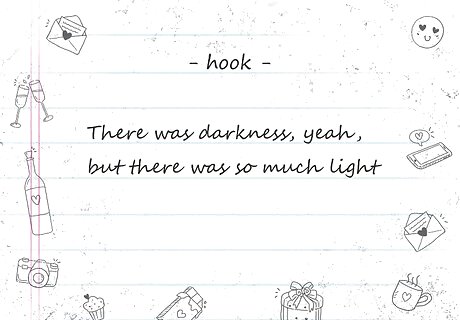
Start with a hook. The hook is the chorus of your song. Some beginning songwriters find it easier to write the hook first, then compose the rest of the lyrics. Familiarize yourself with the beat and melody of the song, then try to write the chorus to fit that beat and melody. Think of the hook as the thesis to your love song and try to sum up how you feel about your crush in a single statement. Brainstorm some ideas, then try to write the chorus based off those. You may write down a few keywords that come to mind when you think about your crush, such as “smart”, “strong”, “hot”, “brave”, or “sensual.” The lyrics for the chorus can be very simple like “Hit me baby one more time” or “Come on ride the train. Ride it!” You may combine a few keywords to create the chorus, “She’s smart, strong, and hot”, or “He’s brave, sensual, and strong.” Typically, the title of the song should also appear in the chorus. For example, if you use the chorus, “She’s smart, strong, and hot”, the song may be called “Smart, Strong, and Hot.”
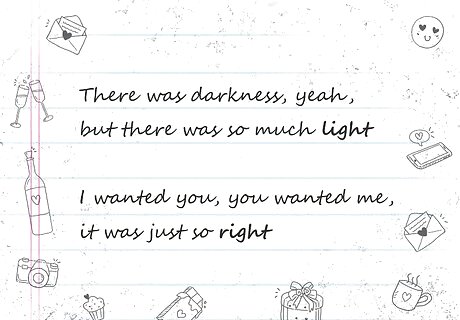
Determine the rhyming structure. Part of what makes a good chorus is setting up and paying off a rhyme. There are many ways to set up the rhyming structure of your chorus and there’s no right or wrong way to go about doing it. Your options for the rhyming structure are: Repeat the same line at least three times. If you choose to do this, make sure the line is fun to say or sing. For example, you may repeat the line, “I think you’re great” three times. When writing a four line chorus, rhyme the first line to the third line and the second line to the fourth line. For example, you may have the lines: “I think you’re great/We would be so good together/You’re the perfect mate/I think we could be forever.” Make the first and third lines the same and make the second and fourth lines the same. For example, you may have the lines: “I think you’re great/We would be so good together/You’re the perfect mate/I think we could be something special.” Make the first three lines the same, then diverge from the pattern for the fourth line. For example, you may have the lines: “I think you’re great/The perfect mate/I can’t wait/For us to be together.” Make all four lines completely different. For example, you may have the lines: “I think you’re great/We would be so good together/You’re my ideal/I want to date you.”
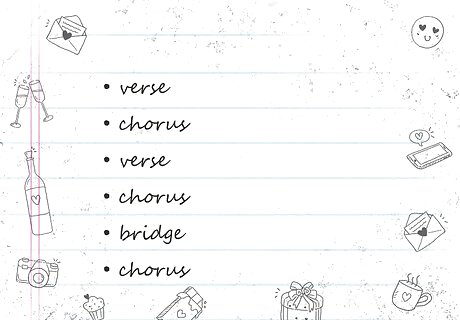
Put the choruses in order. There are many different places a chorus can go within the confines of a song. Most people choose to alternate verses and choruses, but there is no hard and fast rule on this. Some songs repeat the chorus of the song over and over to help signify that the song is ending. If you choose to add a bridge, you’ll want to position an additional chorus after the bridge.
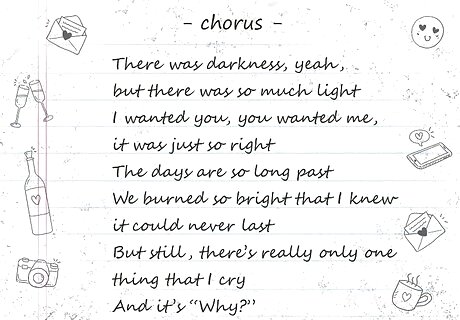
Make the chorus memorable. Your chorus will continue to reappear throughout the course of the song, so it’s important that the chorus be catchy enough that your crush will want to listen to it over and over again. Infuse the chorus with emotion to help show your crush how you really feel. You may talk about your feelings and emotions as well as the qualities that you appreciate in your crush. Another option is to write a chorus that sounds completely different from the rest of the verses. Try mixing up the rhythm or chord projections, changing keys or applying shifts in volume. If you know how, you can also add harmonies or instruments to enhance the chorus.
Writing the Verses

Write down how you feel about your crush. The verses will make up the majority of your song, so you want to use them to show your crush how you really feel about them. Brainstorm ideas by writing down your feelings, memories, or any moments you’ve spent with your crush that have made you happy. Read the writing out loud and look for keywords that stand out. Make a list of these words and use them as the foundation for your verse lyrics. Taylor Swift Taylor Swift, Singer & Businesswoman Make music to help channel your emotions. "There are so many emotions that you're feeling, you can get stifled by them if you're feeling them all at once. What I try to do is take one moment - one simple, simple feeling - and expand it into three-and-a-half minutes."
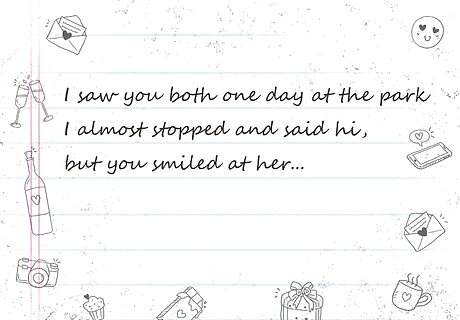
Build on texts you’ve already written about your crush. If you’ve ever written anything about your crush, you can use your previous writing in your song lyrics. Look back at old diary entries, texts, tweets or poems you’ve written to or about your crush. Try taking an individual line from something you’ve already written and building this into the verses of your song. You can also look at things your crush has written to or about you and mine those for inspiration.
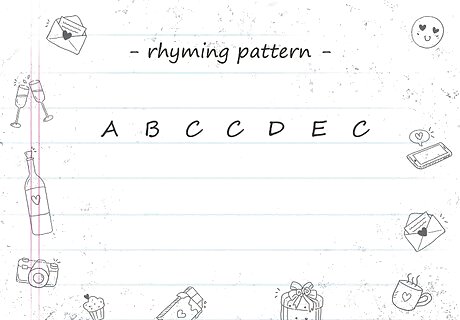
Figure out the rhyming pattern. Verses, like choruses, don’t always rhyme. If you want your verses to rhyme, check out a rhyming dictionary and look for places where you can change words to fit your rhyming pattern. Your words don’t always have to rhyme perfectly. Try using slant rhymes (like rhyming kiss and abyss). It’s better to have a song that doesn’t rhyme then to pick words that rhyme but don’t make sense in your song.
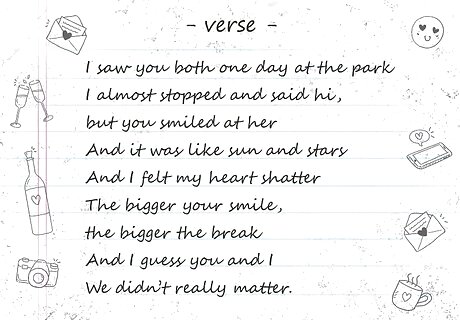
Make the verses personal and specific to your crush. You are writing a love song for your crush only. You should try to make the lyrics specific to your crush, as this will make the song seem more genuine and heartfelt. Use personal experiences and details about your crush in the song. You may include inside jokes that you both share, such as a funny moment at work or at school. You may mention the inside joke in your lyrics to add a nice personal touch to the song. You may also mention specific details or traits that you admire or like about your crush. Try mentioning a specific moment when you noticed this trait or detail, such as the time your crush helped you solve a problem on the computer, showing you that they are sexy and computer savvy. Or the time your crush helped you move into your new apartment, a moment where you realized your crush was strong and supportive.
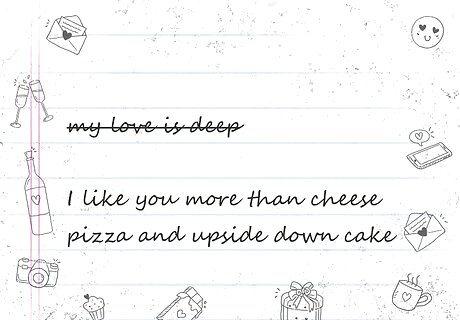
Avoid cliche descriptions and details. Love songs can become familiar and generic very fast, as there are too many cliches out there about love. A cliche is a phrase that has become so familiar it loses its meaning. You should avoid cliches in your love song so it feels specific to your crush and makes the emotional impact you are hoping for. For example, avoid familiar descriptions of love, like “my love is deep” or “my love is everlasting.” You should also avoid describing your feelings for your crush with cliche details, like “my heart cries for you” or “I want you so bad.” Instead, go for descriptions and details that feel unique and unfamiliar. Try describing your feelings for your crush in a funny and creative way, like “I like you more than cheese pizza and upside down cake” or “I think you’re cooler than anyone I know.” Make the lyrics fun and interesting so your crush gets drawn into your love song.
Writing the Bridge
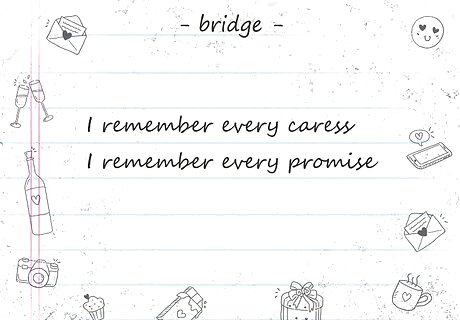
Write the lyrics for the bridge. A bridge is used to break up a song – it’s a departure from the verses and chorus and can infuse a totally different feeling into a piece of music. Write lyrics for the bridge that are emotionally based and that heighten the feeling of love in your song. If you spend the entire song talking about how much you love your crush, use the bridge to describe the feeling you get when they’re not around. Build the energy throughout the bridge to help make your final chorus that much more powerful.

Switch up the melody in the bridge. Since the bridge is meant to be a change from the rest of the song, you want to use the bridge’s melody to reflect that. Experiment with writing a new chord progression for the bridge. If the rest of the song is in a major key, switch to minor for the bridge. Borrow chord progressions from different keys for the bridge. Since the bridge is a heightening of the song, play around with setting the bridge in a higher key. End the bridge with an open chord or non-tonic chord.
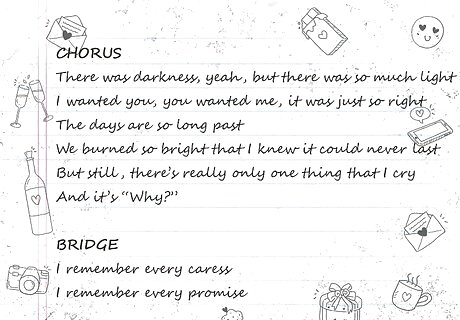
Add the bridge to the song. Most songs are laid out like this: verse, chorus, verse, chorus, bridge, chorus. Your song does not have to follow this format, but you can definitely use it as a template as you construct the order of your song. Some songs include third verses. If you have a third verse, position the third verse after the bridge, but before the last chorus. If you only have two verses, repeat the chorus twice after the bridge to capitalize on the energy built in the bridge section.



















Comments
0 comment